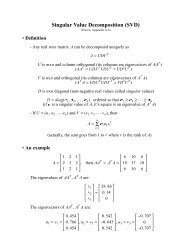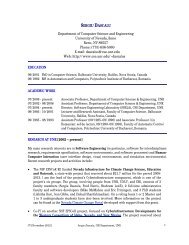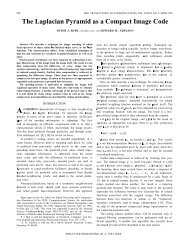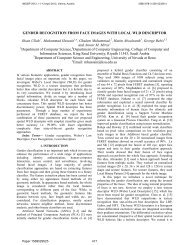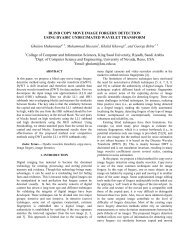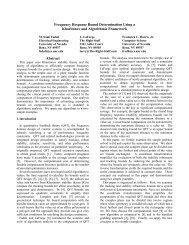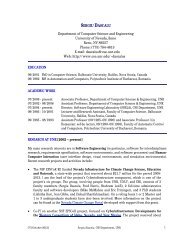A Diary Study of Task Switching and Interruptions
A Diary Study of Task Switching and Interruptions
A Diary Study of Task Switching and Interruptions
Create successful ePaper yourself
Turn your PDF publications into a flip-book with our unique Google optimized e-Paper software.
CHI 2004 ׀ Paper 24-29 April ׀ Vienna, Austria<br />
A <strong>Diary</strong> <strong>Study</strong> <strong>of</strong> <strong>Task</strong> <strong>Switching</strong> <strong>and</strong> <strong>Interruptions</strong><br />
ABSTRACT<br />
We report on a diary study <strong>of</strong> the activities <strong>of</strong> information<br />
workers aimed at characterizing how people interleave<br />
multiple tasks amidst interruptions. The week-long study<br />
revealed the type <strong>and</strong> complexity <strong>of</strong> activities performed,<br />
the nature <strong>of</strong> the interruptions experienced, <strong>and</strong> the<br />
difficulty <strong>of</strong> shifting among numerous tasks. We present<br />
key findings from the diary study <strong>and</strong> discuss implications<br />
<strong>of</strong> the findings. Finally, we describe promising directions in<br />
the design <strong>of</strong> s<strong>of</strong>tware tools for task management,<br />
motivated by the findings.<br />
Author Keywords<br />
Multitasking, diary study, task switching, interruptions,<br />
information worker, <strong>of</strong>fice <strong>and</strong> workplace.<br />
ACM Classification Keywords<br />
H5.m. Information interfaces <strong>and</strong> presentation (e.g., HCI).<br />
Mary Czerwinski Eric Horvitz Susan Wilhite<br />
Micros<strong>of</strong>t Research<br />
One Micros<strong>of</strong>t Way, Redmond, WA USA<br />
{marycz; horvitz; susanw}@micros<strong>of</strong>t.com<br />
INTRODUCTION<br />
Information workers <strong>of</strong>ten interleave multiple projects <strong>and</strong><br />
tasks. Although workers may switch among tasks in a selfguided<br />
manner, a significant portion <strong>of</strong> task switching is<br />
caused by external interruptions. We have sought to<br />
underst<strong>and</strong> the influence <strong>of</strong> interruptions on task switching<br />
for information workers. Beyond underst<strong>and</strong>ing the costs <strong>of</strong><br />
interruption, characterizing the density <strong>and</strong> nature <strong>of</strong><br />
interruptions—<strong>and</strong> user’s experiences with recovery from<br />
interruptions—promises to provide valuable guidance for<br />
designing user interface tools that can assist users’<br />
recovery from interruptions.<br />
We report on a diary study <strong>of</strong> task switching <strong>and</strong><br />
interruptions over the course <strong>of</strong> a week. The study revealed<br />
that participants performed significant amounts <strong>of</strong> task<br />
switching <strong>and</strong> encountered numerous interruptions. We<br />
Permission to make digital or hard copies <strong>of</strong> all or part <strong>of</strong> this work for<br />
personal or classroom use is granted without fee provided that copies are not<br />
made or distributed for pr<strong>of</strong>it or commercial advantage <strong>and</strong> that copies bear<br />
this notice <strong>and</strong> the full citation on the first page. To copy otherwise, or<br />
republish, to post on servers or to redistribute to lists, requires prior specific<br />
permission <strong>and</strong>/or a fee.<br />
CHI 2004, April 24–29, 2004, Vienna, Austria.<br />
Copyright 2004 ACM 1-58113-702-8/04/0004...$5.00.<br />
175<br />
found that the reinstatement <strong>of</strong> complex, long-term projects<br />
is poorly supported by current s<strong>of</strong>tware systems. To<br />
address several key problems with recovery from<br />
interruptions, we discuss several designs for supporting task<br />
switching <strong>and</strong> recovery that were motivated by the results<br />
<strong>of</strong> the study. The contributions <strong>of</strong> this research include a<br />
characterization <strong>of</strong> <strong>of</strong>fice workers’ multitasking behaviours<br />
over a week, <strong>and</strong> the formulation <strong>of</strong> designs for s<strong>of</strong>tware<br />
tools that promise to enhance productivity.<br />
RELATED WORK<br />
Information workers are <strong>of</strong>ten governed by multiple tasks<br />
<strong>and</strong> activities that they must remember to perform, <strong>of</strong>ten in<br />
parallel or in rapid succession. This list <strong>of</strong> things to be<br />
done typically spans multiple media types, such as sticky<br />
notes, electronic to-do lists, calendar entries, <strong>and</strong> the like.<br />
A failure to remember a task that needs to be performed in<br />
the future has been referred to as a prospective memory<br />
failure [10]. Beyond simply remembering, successful<br />
prospective memory requires recall at the appropriate<br />
moment in time. Increasing numbers <strong>of</strong> interruptions <strong>and</strong><br />
items to be remembered can wreak havoc with both aspects<br />
<strong>of</strong> prospective memory, <strong>and</strong> hence, can reduce an <strong>of</strong>fice<br />
worker’s daily productivity.<br />
A growing body <strong>of</strong> work has already shown prospective<br />
memory failures to be a significant problem for information<br />
workers [5, 28, 33, 35]. Researchers have found that users<br />
devise unique strategies for remembering in attempts to<br />
minimize prospective memory failures [3, 13, 18], such as<br />
emailing reminders to themselves or even creating web<br />
pages that encode a set <strong>of</strong> task reminders. Nevertheless,<br />
very little is known about why those mechanisms are useful<br />
for recalling tasks or how technology might be better<br />
designed to help users reduce forgetting the details <strong>of</strong><br />
important information throughout their busy lives.<br />
<strong>Interruptions</strong> <strong>of</strong> tasks are one <strong>of</strong> the most frequently cited<br />
reasons for prospective memory failures during the work<br />
day [28]. A number <strong>of</strong> research efforts have been aimed at<br />
better underst<strong>and</strong>ing the effects <strong>of</strong> interruptions during<br />
computing tasks (e.g., [4, 12, 15, 24, 26, 28]). This<br />
growing body <strong>of</strong> research highlights the difficulty that users<br />
have with returning to disrupted tasks following an<br />
interruption, such as an instant message, phone call, or<br />
engagement by a colleague. But just how many<br />
Volume 6, Number 1
CHI 2004 ׀ Paper 24-29 April ׀ Vienna, Austria<br />
interruptions do typical <strong>of</strong>fice workers experience during a<br />
given day? One group <strong>of</strong> researchers studied 29 hours <strong>of</strong><br />
videotape <strong>of</strong> mobile pr<strong>of</strong>essionals <strong>and</strong> found that<br />
participants in their study experienced, on average, just over<br />
four interruptions per hour [28]. The researchers noted that<br />
subjects found interruptions valuable at times, but generally<br />
characterized them as a nuisance. The study showed that,<br />
40% <strong>of</strong> the time, the disrupted task was not resumed<br />
immediately following the interruption. It is presumed that<br />
the worker does not return to the primary task right away<br />
either because some component <strong>of</strong> the task or surrounding<br />
context has been forgotten, or because it has become too<br />
difficult in some way to resume given the competing<br />
dem<strong>and</strong>s <strong>of</strong> the distraction.<br />
Other related work has focused on designs <strong>and</strong> prototypes<br />
<strong>of</strong> tools for assisting with recall. For example, researchers<br />
have found that a navigable video log <strong>of</strong> a computer screen<br />
over a day <strong>of</strong> activities can be used as a memory-jogging<br />
tool. Review <strong>of</strong> such video logs has been shown to be<br />
especially beneficial to users after longer periods <strong>of</strong> elapsed<br />
time [5, 22]. Although video diary tools may be valuable,<br />
they require time for review—time that busy multitasking<br />
information workers may not have to spare.<br />
Recently, several researchers have attempted to create userinterface<br />
designs that help computer users with<br />
remembering items in the short term. In one study,<br />
investigators found that providing a history <strong>of</strong> recent<br />
actions with explanations was useful for error recovery<br />
during s<strong>of</strong>tware development [30]. In an application<br />
developed for users <strong>of</strong> mobile devices [21], users’ physical<br />
locations, workstation activities, file exchanges, printing,<br />
phone calls, email, <strong>and</strong> colleagues present at meetings, etc.<br />
are continuously logged. The system later displays these<br />
events <strong>and</strong> allows the user to filter content on key event<br />
details, like time, person, place, etc. The Remembrance<br />
Agent [31] is an automatic text retrieval system based on a<br />
user’s current location. The system returns information<br />
about other users or items available in the system based on<br />
the user location <strong>and</strong> the relatedness <strong>of</strong> the items.<br />
Rekimoto’s Time-Machine Computing [29] provides access<br />
to desktop contents along a time line, <strong>and</strong> generates<br />
visualizations <strong>of</strong> content based on frequency <strong>of</strong> access.<br />
Other systems, such as Cyberminder [8], Memory Glasses<br />
[7], Lifestreams [11], have been designed to support users’<br />
memory in real time while computing with time-centric<br />
visualizations.<br />
DIARY STUDY<br />
Given the paucity <strong>of</strong> empirical studies <strong>of</strong> the usefulness <strong>of</strong><br />
tools that have been proposed for assisting with task<br />
recovery, it remains unclear to what extent these kinds <strong>of</strong><br />
prosthetics actually solve the real needs <strong>of</strong> busy information<br />
workers. Thus, we undertook a diary study to explore the<br />
extent to which these kinds <strong>of</strong> systems were needed by<br />
knowledge workers. <strong>Diary</strong> studies have high ecological<br />
value as they are carried out in situ, in the users’ real<br />
176<br />
environments. On the negative side, diary studies suffer<br />
from the problem that they are tedious for the recorder <strong>and</strong><br />
they can invoke a “Heisenberg-style” challenge: the process<br />
<strong>of</strong> observing may influence the observations in that<br />
journaling tends to add to the interruption <strong>of</strong> the flow <strong>of</strong><br />
daily events. Despite these problems, we felt it was overall<br />
beneficial to start from ecologically valid data that might<br />
reveal interesting patterns <strong>of</strong> multitasking <strong>and</strong> interruption,<br />
while realizing that there would be imperfections with<br />
regard to comprehensiveness <strong>and</strong> accuracy. Beyond<br />
examining diary logs, we worked to capture users’ personal<br />
descriptions <strong>of</strong> their work. We asked users to label their<br />
tasks when they switched to them, with an eye toward<br />
discovering the different conceptual levels <strong>of</strong> task types that<br />
users might deem important enough to write down. We<br />
were careful not to instruct the participants about what they<br />
should consider tasks to be—we asked them to define them<br />
for us.<br />
After collecting <strong>and</strong> analyzing the diary data from our<br />
participants, we review designs <strong>and</strong> evaluations <strong>of</strong><br />
prototype task-management tools that were motivated by<br />
challenges identified in the study. The emphasis <strong>and</strong><br />
contribution <strong>of</strong> this paper is on providing the HCI<br />
community with additional insights about the degree <strong>and</strong><br />
types <strong>of</strong> multitasking <strong>and</strong> interruption that information<br />
workers experience over a work week, in order to guide the<br />
development <strong>of</strong> s<strong>of</strong>tware tools that can assist the workers<br />
with multitasking.<br />
Method<br />
Eleven experienced Micros<strong>of</strong>t Windows users (3 female)<br />
participated in the study. All <strong>of</strong> the participants reported<br />
multitasking among more than three major projects or tasks<br />
(as defined by the users) on the job, <strong>and</strong> all were<br />
experienced <strong>of</strong>fice s<strong>of</strong>tware users as evaluated by an<br />
internal, validated questionnaire. Participants’ occupations<br />
spanned a spectrum <strong>of</strong> domains, including a stock broker,<br />
pr<strong>of</strong>essor <strong>of</strong> Computer Science, web designer, s<strong>of</strong>tware<br />
developer, boat salesman, <strong>and</strong> network administrator. The<br />
participants’ ages ranged from 25 to 50 years <strong>of</strong> age.<br />
A Micros<strong>of</strong>t Excel XP spreadsheet, with worksheets for<br />
each day <strong>of</strong> the week <strong>and</strong> another for participant<br />
instructions, were created with columns for each tracked<br />
parameter. Columns were created for Time <strong>of</strong> <strong>Task</strong> Start,<br />
Difficulty <strong>Switching</strong> to the <strong>Task</strong>, What Documents Were<br />
Included in the <strong>Task</strong>, What Was Forgotten If Anything,<br />
Comments, <strong>and</strong> the Number <strong>of</strong> <strong>Interruptions</strong> Experienced<br />
<strong>and</strong> the users’ task descriptions. We include as an example<br />
a spreadsheet, for one participant in Figure 1.<br />
We were interested to learn how users defined tasks, <strong>and</strong> in<br />
underst<strong>and</strong>ing personal variation in the granularity at which<br />
tasks are defined. A review <strong>of</strong> the different participants’<br />
spreadsheets revealed that, over the same span <strong>of</strong> time,<br />
different participants in the study chose to encode “task<br />
switches” at different levels <strong>of</strong> detail. In addition, the<br />
number <strong>of</strong> task switches appeared to be influenced by the<br />
Volume 6, Number 1
CHI 2004 ׀ Paper 24-29 April ׀ Vienna, Austria<br />
participants’ occupations. The participant associated with<br />
the log in Figure 1 was a stock broker, <strong>and</strong> his day<br />
consisted <strong>of</strong> a large number <strong>of</strong> client calls—each <strong>of</strong> which<br />
he considered a separate task. Such variation in how people<br />
define tasks suggests that designers <strong>of</strong> tools that support<br />
task recovery will need to provide users with flexibility in<br />
terms <strong>of</strong> the level <strong>of</strong> detail <strong>and</strong> numbers <strong>of</strong> tasks that the<br />
users may wish to use to represent their projects.<br />
Two experimenters coded all <strong>of</strong> the users’ first day diaries<br />
to ensure cross-experimenter validation <strong>and</strong> to test the rich<br />
coding scheme that had been developed. The codes were<br />
derived from reading over the users’ entries <strong>and</strong> partitioning<br />
them into recurring categories. We found that the<br />
experimenters were at 98% agreement in the use <strong>of</strong> the<br />
codes for the first day following an initial phase <strong>of</strong><br />
derivation. Policies were developed for disagreements in<br />
coding applications, <strong>and</strong> these policies were executed for<br />
the remaining diaries. The experimenters split the<br />
remaining four days <strong>of</strong> diary coding but continued to<br />
consult with each other to resolve in a satisfactory manner<br />
the few ambiguous task entries that were noted.<br />
Figure 1. Partial diary for subject MS over a 6 hour period.<br />
Results<br />
Baseline Survey. User responses to a baseline survey<br />
showed that the workers perceived computers as powerful<br />
tools that enhanced their productivity. In general, the<br />
participants believed that their computer files were well<br />
organized <strong>and</strong> that they did not have significant trouble<br />
finding files or information on their computers. We also<br />
found that users in the study included an equal mix <strong>of</strong><br />
workers who described their work as primarily deadline<br />
driven <strong>and</strong> those who were not driven by deadlines (i.e., they<br />
chose what projects to work on <strong>and</strong> when). In addition, we<br />
noted that the participants were proud <strong>of</strong> their ability to<br />
multitask, <strong>and</strong> they reported feeling that multitasking brought<br />
fun <strong>and</strong> variety to their work.<br />
<strong>Diary</strong> Analyses. We performed several analyses on the diary<br />
data. First, frequency counts <strong>of</strong> the number <strong>of</strong> diary entries<br />
for each dependent measure were calculated. In addition,<br />
subjective ratings <strong>of</strong> task-switch difficulty were also<br />
collected for each diary entry. Also, the amount <strong>of</strong> time<br />
spent on the tasks was obtained for each entry. For each <strong>of</strong><br />
177<br />
these statistics, a spreadsheet was calculated for each<br />
participant by day <strong>of</strong> week. Most statistics were then<br />
collapsed across days in order to build an overall picture <strong>of</strong><br />
how participants switched among tasks over the week. The<br />
data was subjected to multivariate logistical regression with<br />
each user’s task switch entry included as input. Statistical<br />
analyses <strong>of</strong> all <strong>of</strong> these metrics are presented in the next<br />
sections.<br />
Types <strong>of</strong> <strong>Task</strong>s. One outlier participant was removed from<br />
the rest <strong>of</strong> the analyses because the subject did not switch<br />
among more than two tasks on any given day <strong>of</strong> the week<br />
(therefore not meeting our criteria for participation). For the<br />
ten remaining participants, we examined the granularity at<br />
which different users defined a task switch. Recalling<br />
another specific example from the diaries, task entries<br />
appeared as follows:<br />
BH (spanning 6 hours):<br />
1. Daily Schedule Preparation<br />
2. Synch PocketPC<br />
3. Check Internet Email<br />
4. Check <strong>and</strong> respond to email<br />
5. Matlab coding<br />
6. Create Charts for Meeting<br />
7. Edit Word documents for meeting<br />
8. Meeting<br />
9. Matlab coding<br />
For all <strong>of</strong> our participants, “email” was clearly considered a<br />
task that had to be dealt with repeatedly throughout the day.<br />
In fact, it <strong>of</strong>ten appeared that anything else that participants<br />
listed in their diaries was their core work, since they spent so<br />
much time in email. Users tended to use generic terms to<br />
describe their tasks, such as “create/edit web pages,” “annual<br />
performance review,” <strong>and</strong> “work on PPT slides” instead <strong>of</strong><br />
using more specific, meaningful keywords to describe their<br />
activities. We found workers’ use <strong>of</strong> simple labels to<br />
describe their activities interesting, as it appears feasible to<br />
use event logging s<strong>of</strong>tware to similarly annotate tasks with<br />
simple terms. As a side note, more descriptive information<br />
was <strong>of</strong>ten written as annotations under the column header,<br />
“What caused the task switch?” In that column, users would<br />
list things such as, “Need to prepare for meeting with<br />
supervisor,” “scheduled quarterly meeting,” “primary job<br />
responsibility,” or “time to go to the gym.” We are not sure<br />
at this point why users chose to write down more meaningful<br />
information about the basis for the task switch in comparison<br />
to their actual task descriptors, but such information might<br />
provide value in applications <strong>and</strong> operating systems that seek<br />
to acquire <strong>and</strong> leverage metadata from users about data <strong>and</strong><br />
tasks. The diary data suggests that users might enter<br />
information that is somewhat abstract when they are<br />
prompted with questions about tasks.<br />
A further breakdown analysis <strong>of</strong> the participants’ reported<br />
task types <strong>and</strong> their frequencies was performed. In total,<br />
Volume 6, Number 1
CHI 2004 ׀ Paper 24-29 April ׀ Vienna, Austria<br />
45% <strong>of</strong> the reported tasks in participants’ diaries were<br />
described as project-related or routine tasks that comprised<br />
the participants’ jobs. We found that 23% <strong>of</strong> the tasks<br />
reported could best be described as “email.” Perhaps more<br />
interestingly, we discovered that participants reported “task<br />
tracking” as comprising 13% <strong>of</strong> their reported task switches.<br />
Our users went to great lengths to track their tasks, including<br />
the use <strong>of</strong> personal digital assistants, working to mirror files<br />
<strong>and</strong> drives, <strong>and</strong> burning CDs <strong>of</strong> their information before<br />
leaving work in the evenings. The frequencies <strong>of</strong> the types <strong>of</strong><br />
tasks are shown in Figure 2.<br />
For most tasks, participants reported an average <strong>of</strong> 1.75<br />
documents being employed in the activity. This number is a<br />
conservative estimate <strong>of</strong> the amount <strong>of</strong> material actually<br />
needed for a task, as some users did not report what<br />
documents they included for a given task switch, <strong>and</strong> some<br />
only used abbreviations (e.g., “several *.doc <strong>and</strong> *.xls files”<br />
was <strong>of</strong>ten an entry a participant would provide in the diary).<br />
In these cases, per our coding conventions, we registered the<br />
most conservative estimate <strong>of</strong> the number <strong>of</strong> documents for<br />
that task–2. In addition, users reported an average <strong>of</strong> 0.7<br />
interruptions per task, almost a one-to-one interruption to<br />
task ratio! This should also be taken as a conservative<br />
estimate, because several users would simply indicate that<br />
they had received “multiple” interruptions during a task,<br />
Telephone Call<br />
8%<br />
Routine <strong>Task</strong><br />
27%<br />
<strong>Task</strong> Tracking<br />
13%<br />
Frequency <strong>of</strong> <strong>Task</strong> Type<br />
Downtime<br />
0.3%<br />
Project<br />
18%<br />
Email<br />
23%<br />
Meeting<br />
6%<br />
Personal<br />
5%<br />
Figure 2. Frequency <strong>of</strong> diary entries for various task types.<br />
Routine tasks, reading email, <strong>and</strong> project-related work<br />
comprised the majority <strong>of</strong> our users’ days.<br />
wherein the experimenter could only assume more than one<br />
(e.g., 2). Finally, on average, our participants reported that<br />
most task switching was relatively easy (average rating = 1.4,<br />
on a difficulty rating scale where 1=low, 2=medium <strong>and</strong><br />
3=high). This is underst<strong>and</strong>able, given that email was almost<br />
always rated as relatively easy to switch to, <strong>and</strong> that email<br />
comprised approximately one quarter <strong>of</strong> the entries across all<br />
diaries. Most tasks were rated as “high priority” on average.<br />
In other words, our participants indicated that what they<br />
mostly worked on during the course <strong>of</strong> a day was important<br />
to them <strong>and</strong>/or their organization or clients.<br />
178<br />
Reported task lengths averaged 53 minutes, with a large<br />
st<strong>and</strong>ard deviation <strong>of</strong> 90.9 minutes. The distribution <strong>of</strong> task<br />
lengths was highly negatively skewed, with the majority <strong>of</strong><br />
the tasks reported being shorter than the average length.<br />
However, several tasks were reported that lasted throughout<br />
the course <strong>of</strong> the work week.<br />
<strong>Task</strong> Shift Initiators. Next, we analyzed the frequencies <strong>of</strong><br />
different kinds <strong>of</strong> task switches. We found that the largest<br />
category <strong>of</strong> task switches (40%) were self initiated—a clear<br />
indication that our users were typical information workers<br />
that h<strong>and</strong>led their own schedules to a certain degree. 19% <strong>of</strong><br />
the task switches were simply moving on to a new task that<br />
was on a to-do list that the user maintained in either a digital<br />
or paper format. Telephone calls prompted 14% <strong>of</strong> the<br />
reported task switches, while meetings <strong>and</strong> appointment<br />
reminders prompted another 10%. Deadlines <strong>and</strong><br />
emergencies accounted for only 3% <strong>of</strong> the reported task<br />
switches, despite the self-reported reliance upon deadlines by<br />
a number <strong>of</strong> the participants. This could again indicate that<br />
our participants preferred to h<strong>and</strong>le their own schedule to a<br />
large degree, despite looming deadlines, so as to maintain<br />
maximal flexibility. Email content prompted task switches in<br />
3% <strong>of</strong> the reported cases, <strong>and</strong> a new information need or<br />
request from a colleague or client prompted another 3%.<br />
These data are shown in Figure 3.<br />
Self-Initiated<br />
40%<br />
Frequency <strong>of</strong> Switch Causes<br />
App Prompt<br />
Telephone<br />
1%<br />
Call<br />
Appointment<br />
14%<br />
9%<br />
Deadline<br />
2%<br />
Email<br />
Emergency<br />
3%<br />
1%<br />
New<br />
Information<br />
Request<br />
3%<br />
Next <strong>Task</strong><br />
19%<br />
Other Person<br />
1%<br />
Return to <strong>Task</strong><br />
7%<br />
Figure 3. The frequency <strong>of</strong> diary entries for the kinds <strong>of</strong><br />
events that instigated task switches. For our sample,<br />
users chose when to switch tasks or worked <strong>of</strong>f a to-do list<br />
a majority <strong>of</strong> the time.<br />
Difficulty <strong>Task</strong> <strong>Switching</strong>. Subjects reported that more<br />
complex tasks, especially those that lasted longer <strong>and</strong><br />
included more documents, were more difficult to switch to.<br />
<strong>Task</strong>s that required “returning to” after an interruption were<br />
rated significantly more difficult to switch to than others,<br />
F(1,497)= 8.453, p
CHI 2004 ׀ Paper 24-29 April ׀ Vienna, Austria<br />
Difficulty <strong>Switching</strong> (1=Low,<br />
2=Med, 3=High)<br />
3<br />
2<br />
1<br />
0<br />
Rated Difficulty Sw itching to <strong>Task</strong><br />
<strong>Task</strong> Type<br />
Other <strong>Task</strong>s<br />
Returned-to <strong>Task</strong>s<br />
Figure 4. Average rated difficulty <strong>of</strong> switching to returned-to<br />
tasks v. other tasks.<br />
The returned-to tasks were over twice as long as those tasks<br />
described as more routine, shorter-term projects (average<br />
task length = 120 minutes v. 45 minutes, respectively),<br />
F(1,494)= 23.95, p
CHI 2004 ׀ Paper 24-29 April ׀ Vienna, Austria<br />
projects were also rated significantly harder to return to<br />
than shorter-term projects. Returned-to tasks were over<br />
twice as long as other tasks, accounting for over 11% <strong>of</strong> a<br />
user’s total work week, on average. We found that<br />
reacquiring such tasks is not well supported in the s<strong>of</strong>tware<br />
our participants were using, <strong>and</strong> their diaries included<br />
comments on this.<br />
The key findings gleaned from the diary study, as well as<br />
explicit comments from participants, shaped our pursuit <strong>of</strong><br />
designs for user interface tools that might better assist users<br />
with task switching. The results <strong>and</strong> comments especially<br />
call out the need for s<strong>of</strong>tware support to ease the challenge<br />
<strong>of</strong> switching back to all projects, but especially to<br />
recovering long-lived projects after interruptions.<br />
The design ideas most frequently <strong>of</strong>fered by the participants<br />
revolved around creating new tools for reminding,<br />
including the potential value <strong>of</strong> cross-application project<br />
<strong>and</strong> to-do list tracking. Participants commented explicitly<br />
that better reminders would help them get back on tasks<br />
more quickly. Such tools would likely grow in value as<br />
tasks grow in duration, given the increases in the number <strong>of</strong><br />
interruptions with project duration, <strong>and</strong>, more generally, the<br />
overall toll on retrospective memory for task content <strong>and</strong><br />
goals observed with the passage <strong>of</strong> time [5]. In one<br />
approach to tools for tracking, productivity s<strong>of</strong>tware<br />
applications could be designed to maintain project-specific<br />
state (e.g., re-establishing the layout <strong>of</strong> multiple windows,<br />
<strong>and</strong> bringing users back to where they were at the<br />
interruption), <strong>and</strong> to provide better reminders (both<br />
prospective <strong>and</strong> retrospective), better summary views <strong>of</strong><br />
computer work over time, <strong>and</strong> means for filtering tasks by<br />
project. Currently supported s<strong>of</strong>tware reminding tools<br />
such as meeting announcements <strong>and</strong> to-do list reminders<br />
could be extended in that they could be made more projectspecific,<br />
as opposed to application-specific, as our<br />
participants pointed out in their diaries. Also, as task<br />
switches were <strong>of</strong>ten prompted by phone calls, email, or<br />
personal requests, improved integration across applications<br />
(e.g., the phone, email, web services, instant messaging,<br />
etc.) could benefit users’ multitasking <strong>and</strong> recovery.<br />
The development <strong>of</strong> tools for easing the reinstatement <strong>of</strong><br />
context <strong>and</strong> associated resources appears to be a significant<br />
opportunity area. Some users, resonating with entries across<br />
many <strong>of</strong> the diaries, suggested that a form <strong>of</strong> autocategorization<br />
<strong>of</strong> their task-related documents across<br />
applications would help them when returning to projects.<br />
Tools providing automated or manual coalescence <strong>of</strong><br />
resources associated with a project could minimize the cost<br />
<strong>of</strong> returning to a long-term project. Such tools would likely<br />
assist users with storing <strong>and</strong> recalling sets <strong>of</strong> applications<br />
<strong>and</strong> documents, including the physical layout <strong>of</strong> files on a<br />
display.<br />
These results, ideas <strong>and</strong> comments provide guidance for<br />
designing tools for reminding <strong>and</strong> reinstating resources for<br />
projects. We believe that such innovations promise to<br />
180<br />
increase worker satisfaction <strong>and</strong> efficiency by better<br />
supporting task switching <strong>and</strong> recovery from interruption.<br />
We have focused initially on methods that can preserve <strong>and</strong><br />
recreate multiple resources representing the state <strong>of</strong> a<br />
project over time.<br />
INITIAL PROTOTYPE DIRECTIONS AND IMPLICATIONS<br />
Guided by the concepts derived from users, we have<br />
focused on designs that hinge on the use <strong>of</strong> lightweight,<br />
temporal cues, such as the state <strong>of</strong> a user’s desktop at<br />
various times throughout a day [16]. We are also building<br />
support for context-aware, project-based visualizations <strong>and</strong><br />
task switching, in a similar vein to the work <strong>of</strong> [1, 2, 6, 9,<br />
14, 20, 23, 25, 32]. An initial prototype, the GroupBar,<br />
provides users with the ability to organize project-related<br />
documents, email <strong>and</strong> other windows together in the<br />
Windows XP taskbar. GroupBar has been recently<br />
described elsewhere [34]. We shall review key properties <strong>of</strong><br />
the tool here to emphasize how our empirical work inspired<br />
the design efforts.<br />
Project support with GroupBar is afforded by allowing the<br />
user to drag <strong>and</strong> drop taskbar “tiles” on top <strong>of</strong> each other,<br />
forming a group <strong>of</strong> items in the bar that can then be<br />
operated on as a unit. Inspired by past work in the area <strong>of</strong><br />
windows management (e.g., [17, 19, 27]), GroupBar also<br />
provides support for windows management <strong>and</strong> task layout;<br />
once the user lays out their work in a preferred<br />
configuration, GroupBar remembers <strong>and</strong> “rehydrates” these<br />
layouts regardless <strong>of</strong> whether or not the windows <strong>and</strong>/or<br />
applications are currently open. Based on the diary study<br />
findings, this relief from the mechanical aspects <strong>of</strong> having<br />
to tediously retrieve <strong>and</strong> arrange windows promises to save<br />
users time when multitasking <strong>and</strong> task switching. To <strong>of</strong>fer<br />
users further support for recovery, GroupBar can also<br />
suggest potential layouts to the user based on the display<br />
configuration (i.e., a tiled view <strong>of</strong> the required documents<br />
<strong>and</strong> windows that respects the user’s monitor bezels,<br />
resolution, number <strong>of</strong> monitors or other settings). User<br />
studies with the GroupBar [34] revealed that knowledge<br />
workers appreciated these sorts <strong>of</strong> tools, <strong>and</strong> we were<br />
inspired to design additional visualizations that <strong>of</strong>fer<br />
general support for multitasking across different display<br />
sizes <strong>and</strong> configurations. A fragment <strong>of</strong> the groupbar<br />
prototype design is shown in Figure 8.<br />
Given users’ needs for not only underst<strong>and</strong>ing what they<br />
were doing before an interruption, but also what important<br />
tasks are looming in order to better plan their time, we are<br />
exploring a range <strong>of</strong> designs, spanning a spectrum <strong>of</strong><br />
complexity from relatively simple online to-do lists to more<br />
advanced timeline-based visualizations <strong>of</strong> projects. Easy-touse<br />
to-do lists <strong>and</strong> reminders structured on a per task basis<br />
will likely provide value to the end user, based on the data<br />
from this study. On the more advanced methods, there is<br />
opportunity for building meaningful visualizations<br />
automatically by encoding <strong>and</strong> abstracting users’ computing<br />
events over time, via the use <strong>of</strong> such analytical methods as<br />
Volume 6, Number 1
CHI 2004 ׀ Paper 24-29 April ׀ Vienna, Austria<br />
those employed in [6]. In pursuit <strong>of</strong> such visualizations, we<br />
have developed an event recorder, <strong>and</strong> are currently<br />
analyzing the data from a set <strong>of</strong> <strong>of</strong>fice workers at our<br />
organization. We hope to be able to identify useful patterns<br />
in the usage data that might assist users in reviewing or<br />
reinstating task contexts. In summary, guided by the data<br />
obtained from the diary study, we seek to underst<strong>and</strong> the<br />
potential benefits from the use <strong>of</strong> simple <strong>and</strong> more<br />
advanced tools, iterate their designs over time, <strong>and</strong> report<br />
on our progress using both controlled laboratory <strong>and</strong> in situ<br />
research methods.<br />
Figure 8: Fragment <strong>of</strong> GroupBar in its horizontal form factor.<br />
CONCLUSION<br />
We reported on an in situ diary study that we undertook to<br />
characterize the amount <strong>of</strong> task switching <strong>and</strong> interruptions<br />
experienced by typical knowledge workers over the course<br />
<strong>of</strong> a work week. We presented the results <strong>of</strong> the study, <strong>and</strong><br />
provided an analysis <strong>of</strong> the challenges that users have with<br />
switching among tasks. The set <strong>of</strong> results shows that task<br />
complexity, task duration, length <strong>of</strong> absence, number <strong>of</strong><br />
interruptions, <strong>and</strong> task type influence the perceived<br />
difficulty <strong>of</strong> switching back to tasks. Specifically, complex,<br />
“returned-to” tasks comprise a significant portion <strong>of</strong> an<br />
information worker’s week, but reacquiring such tasks is<br />
considered difficult by users.<br />
We undertook the study to identify challenges <strong>and</strong> to seek<br />
additional guidance for designing supportive user interface<br />
tools that might reduce the difficulty <strong>of</strong> multitasking. It is<br />
clear that more can be done within the operating system <strong>and</strong><br />
s<strong>of</strong>tware applications to help users multitask <strong>and</strong> recover<br />
from task interruptions, hence potentially increasing<br />
productivity. The findings suggest that methods for<br />
capturing <strong>and</strong> remembering representations <strong>of</strong> tasks may be<br />
valuable in both reminding users about suspended tasks,<br />
<strong>and</strong> in assisting users to switch among the tasks. Examples<br />
<strong>of</strong> such methods include time-centric visualizations <strong>and</strong><br />
tools that can record, <strong>and</strong> reconfigure upon dem<strong>and</strong>, the<br />
layout <strong>of</strong> multiple windows <strong>of</strong> content <strong>and</strong> applications that<br />
comprise a task. We reviewed efforts on the latter centering<br />
on a re-design <strong>of</strong> the Windows XP taskbar to provide users<br />
with the ability to record <strong>and</strong> reconfigure the layout <strong>of</strong><br />
windows associated with a task.<br />
In summary, the diary results provided us with useful<br />
guidance for formulating designs for task-management<br />
tools. We are in the process <strong>of</strong> characterizing <strong>and</strong> refining<br />
designs via longitudinal user studies. We believe that<br />
continuing research on task recovery will yield new kinds<br />
<strong>of</strong> project management tools that promise to enhance the<br />
productivity <strong>and</strong> satisfaction <strong>of</strong> information workers.<br />
181<br />
ACKNOWLEDGMENTS<br />
We thank our anonymous reviewers for their helpful<br />
comments.<br />
REFERENCES<br />
1. Bannon, L., Cypher, A., Greenspan, S., <strong>and</strong> Monty, M.<br />
(1983). Evaluation <strong>and</strong> analysis <strong>of</strong> user’s activity<br />
organization”. In Proc. CHI’83 (pp. 54-57). NY: ACM.<br />
2. Card, S.K. & Henderson, A.H. Jr. (1987). A multiple,<br />
virtual-workspace interface to support user task<br />
switching. In: Proceedings <strong>of</strong> the CHI+GI, Toronto,<br />
Canada. ACM Press, 53-59.<br />
3. Chambers, C.V., Balaban, D.J., Carlson, B.L.,<br />
Ungemack, J.A. MPH &Grasberger, D.M. (1989).<br />
Microcomputer-generated reminders: Improving the<br />
compliance <strong>of</strong> primary care physicians with<br />
mammography screening guidelines. Journal <strong>of</strong> Family<br />
Practice, 29(3), 273-280.<br />
4. Czerwinski, M., Cutrell, E., & Horvitz, E. (2000).<br />
Instant Messaging <strong>and</strong> Interruption: Influence <strong>of</strong> <strong>Task</strong><br />
Type on Performance. Proceedings <strong>of</strong> OZCHI 2000,<br />
356-361.<br />
5. Czerwinski, M. & Horvitz, E. (2002). Memory for Daily<br />
Computing Events. In Faulkner, X., Finlay, J. &<br />
Detienne, F. (Eds.), People <strong>and</strong> Computers XVI,<br />
Proceedings <strong>of</strong> HCI 2002, 230-245.<br />
6. Derthick, M. & Roth, S.F. (2000). Data exploration<br />
across temporal contexts, Proceedings <strong>of</strong> the<br />
International Conference on Intelligent User Interfaces<br />
(IUI 2000), New Orleans, LA, 60-67.<br />
7. DeVaul, R.W., Clarkson, B. & Pentl<strong>and</strong>, A.S. (2000).<br />
The memory glasses: Towards a wearable, contextaware,<br />
situation-appropriate reminder system.<br />
http://web.media.mit.edu/~rich/memory/SIUC00/Main.h<br />
tml.<br />
8. Dey, A.K. & Abowd, G.D. (2000). CyberMinder: A<br />
context-aware system for supporting reminders. In<br />
Proceedings <strong>of</strong> HUC 2000, 172-186.<br />
9. Dey, A.K., Abowd, G.D., Wood, A.<br />
CyberDesk: A Framework for Providing Self-<br />
Integrating Context-Aware Services<br />
Proceedings <strong>of</strong> the International Conference on<br />
Intelligent User Interfaces (IUI '98), 47-54.<br />
10. Ellis, J. & Kvavilashvili, L. (2000). Prospective<br />
memory in 2000: Past, present <strong>and</strong> future directions.<br />
Applied Cognitive Psychology, 14, 1-9.<br />
11. Fertig, S., Freeman, E. & Gelernter, D. (1996).<br />
Lifestreams: An alternative to the desktop metaphor. In<br />
Proceedings <strong>of</strong> ACM CHI ’96 Conference on Human<br />
Factors in Computing Systems, Extended Abstracts,<br />
ACM Press, 410-411.<br />
12. Gillie, T. Broadbent, D. (1989). What Makes<br />
<strong>Interruptions</strong> Disruptive? A <strong>Study</strong> <strong>of</strong> Length, Similarity,<br />
<strong>and</strong> Complexity. Psychological Research, 50, 243-50.<br />
Volume 6, Number 1
CHI 2004 ׀ Paper 24-29 April ׀ Vienna, Austria<br />
13. Gwizdka, J. (2000). Timely Reminders: A Case <strong>Study</strong> <strong>of</strong><br />
Temporal Guidance in PIM <strong>and</strong> Email Tools Usage.<br />
Extended abstract in Proceedings <strong>of</strong> CHI 2000, Human<br />
Factors in Computing Systems, Volume 2, ACM<br />
Press,163—164.<br />
14. Henderson, D. A. Jr., Card, S.K. (1986). Rooms: The<br />
Use <strong>of</strong> Multiple Virtual Workspaces to Reduce Space<br />
Contention in a Window-based Graphical User<br />
Interface, ACM Transactions on Graphics, Vol. 5, No. 3,<br />
211-243.<br />
15. Hess, S.M. & Detweiler, M.C. (1994). Training to<br />
reduce the disruptive effects <strong>of</strong> interruptions.<br />
Proceedings <strong>of</strong> the Human Factors <strong>and</strong> Ergonomics<br />
Society’s 38 th Annual Meeting, 1173-1177.<br />
16. Hess, S., Detweiler, M.C., & Ellis, R. D. (1999). The<br />
utility <strong>of</strong> display space in keeping-track <strong>of</strong> rapidly<br />
changing information. Human Factors, 41(2), 257-281.<br />
17. Holden, K. L. & O’Neal, M.R. (1992). The utility <strong>of</strong><br />
various windowing capabilities for single-task <strong>and</strong><br />
multi-task environments. In Proceedings <strong>of</strong> CHI'92<br />
Conference on Human Factors in Computing Systems,<br />
Extended Abstracts, ACM Press, 52-53.<br />
18. Jones, W.P., Bruce, H. & Dumais, S. T. (2001). Keeping<br />
found things found on the web. In Proceedings <strong>of</strong><br />
ACM’s CIKM'01, Tenth International Conference on<br />
Information <strong>and</strong> Knowledge Management, 119-126.<br />
19. K<strong>and</strong>ogan, E. <strong>and</strong> Shneiderman, B. (1997). Elastic<br />
Windows: evaluation <strong>of</strong> multi-window operations. In<br />
Proceedings <strong>of</strong> CHI ’97 Conference on Human Factors<br />
in Computing Systems, ACM press, 250-257.<br />
20. Kaptelinin, V. (2002) UMEA: User-Monitoring<br />
Environment for Activities. UIST '02 Companion.<br />
Posters <strong>and</strong> Demos from the 15th Annual ACM<br />
Symposium on User Interface S<strong>of</strong>tware <strong>and</strong> Technology,<br />
31-32.<br />
21. Lamming, M.G. & Newman, W.M. (1992). Activitybased<br />
information retrieval: Technology in support <strong>of</strong><br />
personal memory. Information Processing 92, 3, 68-81.<br />
22. Lamming, M., Brown, P., Carter, K., Eldridge, M.,<br />
Flynn, M., Louie, G., Robinson, P., & Sellen, AJ.<br />
(1994). The design <strong>of</strong> a human memory prosthesis.<br />
Computer Journal, 37(3), 153-163.<br />
23. MacIntyre, B., Mynatt, E., Voida, S., Hansen, K., Tullio,<br />
J., Corso, G. (2001). Support for multitasking <strong>and</strong><br />
background awareness using interactive peripheral<br />
displays. In Proceedings <strong>of</strong> Annual ACM Symposium on<br />
User Interface S<strong>of</strong>tware <strong>and</strong> Technology, UIST 2001,<br />
41-50.<br />
182<br />
24. Maglio, P.P., Campbell, C.S. (2000). Trade<strong>of</strong>fs in<br />
Displaying Peripheral Information. In Proceedings <strong>of</strong><br />
CHI 2000 Conference on Human Factors in Computing<br />
Systems, ACM Press, 241-248.<br />
25. Malone, T. W. (1983). How do people organize their<br />
desks? Implications for the design <strong>of</strong> <strong>of</strong>fice automation<br />
systems, ACM Transactions on Office Information<br />
Systems I, 99-112.<br />
26. McFarlane, D.C. & Latorella, K.A. (2002). The Scope<br />
<strong>and</strong> Importance <strong>of</strong> Human Interruption in HCI design,<br />
Human Computer Interaction, 17, 1-62.<br />
27. Myers, B. (1988). Window interfaces: A taxonomy <strong>of</strong><br />
window manager user interfaces, IEEE Computer<br />
Graphics <strong>and</strong> Applications 8, 5, 65-84.<br />
28. O’Connail, B. & Frohlich, D. (1995). Timespace in the<br />
workplace: Dealing with interruptions. CHI '95<br />
Conference on Human Factors in Computing Systems,<br />
Extended Abstracts, ACM Press, 262-263.<br />
29. Rekimoto, J. (1999). Time-Machine Computing: A<br />
Time-centric Approach for the Information<br />
Environment. In Proceedings <strong>of</strong> Annual ACM<br />
Symposium on User Interface S<strong>of</strong>tware <strong>and</strong> Technology,<br />
UIST ’99, 45-54.<br />
30. Renaud, K. (2000). Expediting rapid recovery from<br />
interruptions by providing a visualization <strong>of</strong> application<br />
activity. Proceedings <strong>of</strong> OZCHI 2000, 348-355.<br />
31. Rhodes B, Starner T. (1996). Remembrance agent: A<br />
continuously running automated information retrieval<br />
system. In Proceedings <strong>of</strong> the First International<br />
Conference on The Practical Application <strong>of</strong> Intelligent<br />
Agents <strong>and</strong> Multi Agent Technology (PAAM '96).<br />
London, UK, 487-495.<br />
32. Robertson, G., van Dantzich, M., Robbins, D.,<br />
Czerwinski, M., Hinckley, K., Risden, K., Thiel, D.,<br />
Gorokhovsky, V. (2000). The <strong>Task</strong> Gallery: a 3D<br />
window manager. In Proceedings <strong>of</strong> CHI 2000<br />
Conference on Human Factors in Computing Systems,<br />
ACM Press, 494-501.<br />
33. Sellen, A.J., Louie, G, Harris, J.E. & Wilkins, A.J.<br />
(1996). What brings intentions to mind? An in situ study<br />
<strong>of</strong> prospective memory. Memory, 5(4), 483-507.<br />
34. Smith, G., Baudisch, P., Robertson, G. G., Czerwinski,<br />
M., Meyers, B., Robbins, D., & Andrews, D. (2003).<br />
GroupBar: The <strong>Task</strong>Bar evolved. Proceedings <strong>of</strong><br />
OZCHI 2003.<br />
35. Terry, W.S. (1988). Everyday forgetting: Data from a<br />
diary study. Psychological Reports, 62, 299-303.<br />
Volume 6, Number 1



